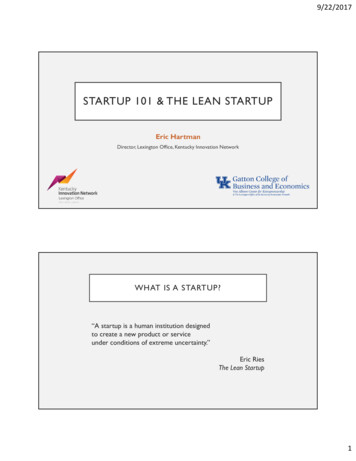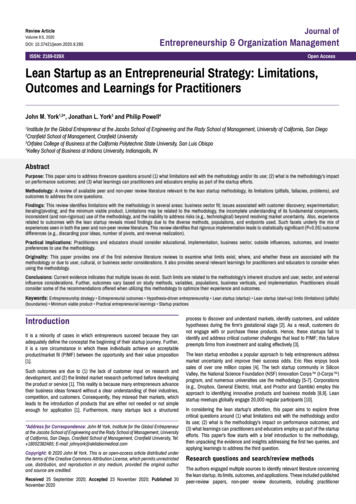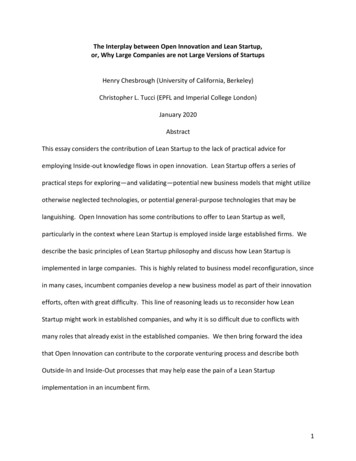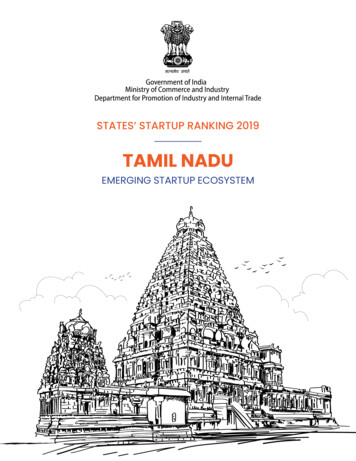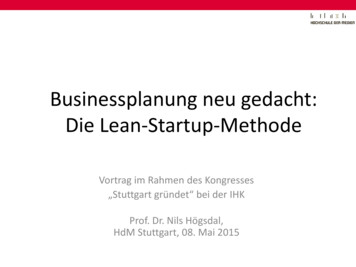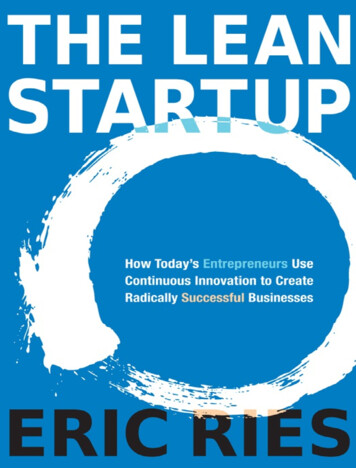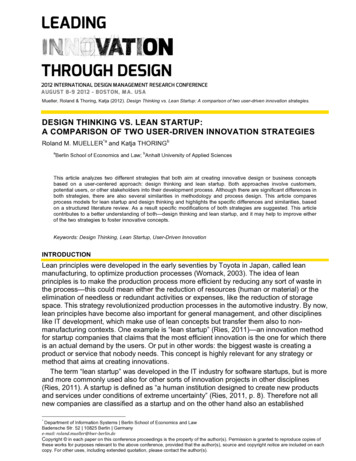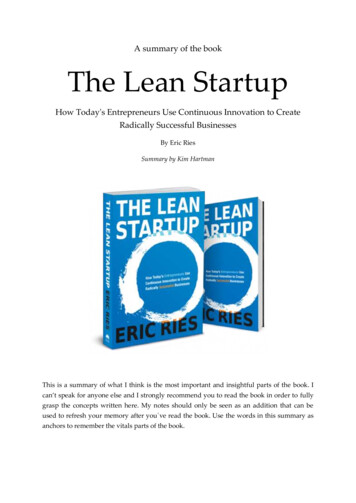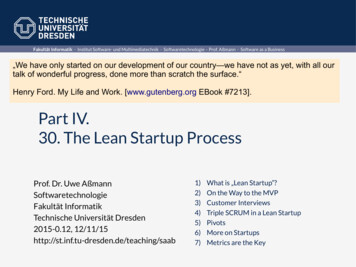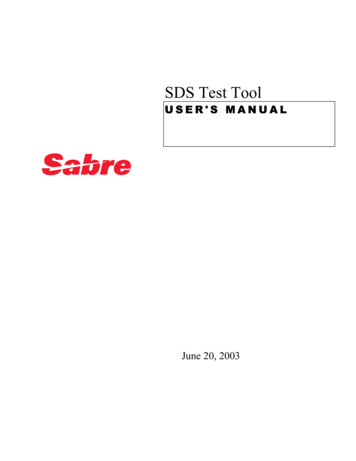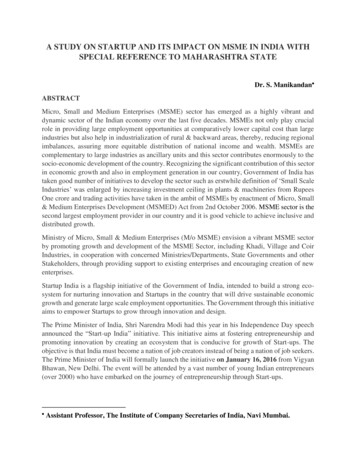
Transcription
A STUDY ON STARTUP AND ITS IMPACT ON MSME IN INDIA WITHSPECIAL REFERENCE TO MAHARASHTRA STATEDr. S. Manikandan ABSTRACTMicro, Small and Medium Enterprises (MSME) sector has emerged as a highly vibrant anddynamic sector of the Indian economy over the last five decades. MSMEs not only play crucialrole in providing large employment opportunities at comparatively lower capital cost than largeindustries but also help in industrialization of rural & backward areas, thereby, reducing regionalimbalances, assuring more equitable distribution of national income and wealth. MSMEs arecomplementary to large industries as ancillary units and this sector contributes enormously to thesocio-economic development of the country. Recognizing the significant contribution of this sectorin economic growth and also in employment generation in our country, Government of India hastaken good number of initiatives to develop the sector such as erstwhile definition of ‘Small ScaleIndustries’ was enlarged by increasing investment ceiling in plants & machineries from RupeesOne crore and trading activities have taken in the ambit of MSMEs by enactment of Micro, Small& Medium Enterprises Development (MSMED) Act from 2nd October 2006. MSME sector is thesecond largest employment provider in our country and it is good vehicle to achieve inclusive anddistributed growth.Ministry of Micro, Small & Medium Enterprises (M/o MSME) envision a vibrant MSME sectorby promoting growth and development of the MSME Sector, including Khadi, Village and CoirIndustries, in cooperation with concerned Ministries/Departments, State Governments and otherStakeholders, through providing support to existing enterprises and encouraging creation of newenterprises.Startup India is a flagship initiative of the Government of India, intended to build a strong ecosystem for nurturing innovation and Startups in the country that will drive sustainable economicgrowth and generate large scale employment opportunities. The Government through this initiativeaims to empower Startups to grow through innovation and design.The Prime Minister of India, Shri Narendra Modi had this year in his Independence Day speechannounced the “Start-up India” initiative. This initiative aims at fostering entrepreneurship andpromoting innovation by creating an ecosystem that is conducive for growth of Start-ups. Theobjective is that India must become a nation of job creators instead of being a nation of job seekers.The Prime Minister of India will formally launch the initiative on January 16, 2016 from VigyanBhawan, New Delhi. The event will be attended by a vast number of young Indian entrepreneurs(over 2000) who have embarked on the journey of entrepreneurship through Start-ups. Assistant Professor, The Institute of Company Secretaries of India, Navi Mumbai.
Clusters are geographic concentrations of interconnected companies, specialized suppliers, serviceproviders, and associated institutions in a particular field that are present in a nation or region.Clusters arise because they increase the productivity with which companies can compete. Thedevelopment and upgrading of clusters is an important agenda for governments, companies, andother institutions. Cluster development initiatives are an important new direction in economicpolicy, building on earlier efforts in macroeconomic stabilization, privatization, market opening,and reducing the costs of doing business.Govt. of India, Ministry of MSME has announced the scheme for Micro and Small enterprises forenhancing their productivity and competitiveness as well as capacity building. The name ofscheme is Micro and Small Enterprises- Cluster Development Programme - MSE-CDP.This study has undertaken to ascertain various issues relating to SME finance from banks takingthe published statistics and primary data into account, to examine the reasons why banks shy awayfrom lending to the sector and what are possible remedies to enhance accessibility of SMEs tobank finance.Keywords: SME’s, Start-up India, SME clusters in Maharashtra, SME Finance
INTRODUCTIONThe Micro, Small and Medium Enterprises Development (MSMED) Act was notified in 2006 toaddress policy issues affecting MSMEs as well as the coverage and investment ceiling of thesector. The Act seeks to facilitate the development of these enterprises as also enhance theircompetitiveness. It provides the first-ever legal framework for recognition of the concept of“enterprise” which comprises both manufacturing and service entities. It defines mediumenterprises for the first time and seeks to integrate the three tiers of these enterprises, namely,micro, small and medium.The Act also provides for a statutory consultative mechanism at the national level with balancedrepresentation of all sections of stakeholders, particularly the three classes of enterprises and witha wide range of advisory functions. Establishment of specific funds for the promotion,development and enhancing competitiveness of these enterprises, notification ofschemes/programmers for this purpose, progressive credit policies and practices, preference inGovernment procurements to products and services of the micro and small enterprises, moreeffective mechanisms for mitigating the problems of delayed payments to micro and smallenterprises and assurance of a scheme for easing the closure of business by these enterprises, aresome of the other features of the Act.Micro, small and medium enterprises as per MSMED Act, 2006 are defined based on theirinvestment in plant and machinery (for manufacturing enterprise) and on equipment for enterprisesproviding or rendering services.Recognizing the contribution and potential of the sector, the definitions and coverage of the SmallScale Industry (SSI) sector were broadened significantly under the Micro, Small and MediumEnterprises Development (MSMED) Act, 2006 which recognized the concept of “enterprise” toinclude both manufacturing and services sector besides, defining the medium enterprises.The present ceilings on investment for enterprises to be classified as micro, small andmedium enterprises are as follows:MANUFACTURING SECTOREnterprisesInvestment in plant & machineryMicro EnterprisesDoes not exceed twenty five lakh rupeesSmall EnterprisesMore than twenty five lakh rupees but does not exceed five crorerupeesMedium EnterprisesMore than five crore rupees but does not exceed ten crore rupees
SERVICE SECTORInvestment in equipment’sEnterprisesMicro EnterprisesDoes not exceed ten lakh rupees:Small EnterprisesMore than ten lakh rupees but does not exceedtwo crore rupeesMedium EnterprisesMore than two crore rupees but does notexceed five core rupeesSalient Features of SME Sectors1. Instant decision making No notes, no papers, no consultation Gut feeling2 Personal Knowledge3 Personal firsthand information4 No time clock for work (0 HRS to 24 HRS )5 Often times –more often than not – everyone in the family is a contributor to business6 Negligible labour problems: interpersonal relationship between the owners and theemployees is intimateWHY SME’s ARE MORE ADOPTABLE?
Indian economy is dominated by a vibrant set of enterprises, which are prestigiously known asMicro, Small and Medium Enterprises (MSMEs) for their scale of operations. The role of MSMEsin economic and social development of country is widely acknowledged. The role of MSMEs ineconomic and social development of country is widely acknowledged.IndependentstructureSimple toorganizedSkill promptersLow riskLow financeMAJOR SECTORS OF SME’sInnovation andnew concepts
Textiles and PaperService industriesAutomotive componentsFood and beveragesITTobacco and eET and othersSTART-UPStartup means an entity, incorporated or registered in India not prior to Five years, with annualturnover not exceeding Rupees 25 Crores in any preceding financial year, working towardsinnovation, development, deployment or commercialization of new products, processes or servicesdriven by technology or intellectual property.Key Points of Start-up Single Window Clearance even with the help of a mobile application10,000 crore fund of funds80% reduction in patent registration feeModified and more friendly Bankruptcy Code to ensure 90-day exit windowFreedom from mystifying inspections for 3 yearsFreedom from Capital Gain Tax for 3 yearsFreedom from tax in profits for 3 yearsEliminating red tapeSelf-certification complianceInnovation hub under Atal Innovation Mission
Starting with 5 lakh schools to target 10 lakh children for innovation Programmenew schemes to provide IPR protection to start-ups and new firmsEncourage entrepreneurship.Stand India across the world as a start-up hub.Benefits of Start-up Scheme1. No tax on income from Startups2. Capital Gains and ARCs3. 1-day incorporation4. Skilling India5. MUDRA scheme6. Presumptive taxation scheme7. Corporate tax for Small CompaniesService Tax exemption8. Rs. 500 cr to support SC/ST, women entrepreneursRESEARCH METHODOLOGYNeed of the StudyTo know the Avenues of financial succor for SMEs & Startups in India with reference to SMEclusters in Maharashtra.Objective of Study1. To find how SMEs and start-ups of contribute to the development of our country.2. To study financial crunch and clusters in financing SMEs & startups and the prominentsource of financing and problems faced by them and the enterprises which the entrepreneurare willing to start and activity which they want to peruse.3. To study the nature of operations and type of organizations and industry.4. To know the Schemes framed by the Government under the MSME Sector.Data CollectionBoth primary and secondary data will be used for this study.Methods of data collection:1. Primary data is collected through survey technique Questionnaire.2. Secondary data is collected from Journals, Internet, Magazines Company’s.
Record Data analysis: Once the data are collected, the information will be coded and appropriatedata analytic techniques will be used to obtain meaningful information from the collected data. Itinvolves editing, coding and tabulating the collected data.Sample size –50 ExpertsSampling technique -In this study, probability/random sampling technique is adopted.Sampling Method -Simple random sampling is used.Simple random sampling: In this method, every element in the population has a known and equalchance of being selected as a sample. This sampling is best suited when the generalizability of thefindings to the whole population is the main objective of the study.REVIEW OF LITERATUREKristin Hallberg, (2000)Governments in both industrialized and developing countries provide a wide variety of programsto assist small- and medium-scale enterprises (SMEs). Despite the success of SME strategies in afew countries, the majority of developing countries have found that the impact of their SMEdevelopment programs on enterprise performance has been less than satisfactory.Krishna Kumar (2003)He views that In India foreign collaborations have generally been to have the technological transferwhich involves high cost. It is important to understand the MSME’s single handed cannot affordthis cost, however if a group of MSME’s of similar nature of work come together the burden ofthe foreign collaborations can be shared effectively.Sickness and Rehabilitation of MSMEs in India (2005)The author feels that the SMEs will fail in a sector for a variety of reasons. Global competitivenesshas strained India’s already weak infrastructure, which severely hinders the production of smallscale industries. There are a multitude of reasons for failure, however, not all of them related tocompetition. Lack of knowledge, available capital, qualified workers or even motivation on thepart of the owner are all viable reasons for business failure. Whatever the reason for failure, thebusiness must have some sort of recourse to ‘declare’ its sickness. In India, what constitutes thismechanism is relatively unclear, and despite current progress, has left much inefficiency.Y.Srinivas (2005)MSMEs play a very significant role in the economy in terms of balanced and sustainable growth,employment generation, development of entrepreneurial skills and contribution to export earnings.However, despite their importance to the economy, most SMEs are not able to stand up to thechallenges of globalisation, mainly because of difficulties in the area of financing. With theopening up of the Indian economy, it has become necessary to consider measures for smootheningthe flow of credit to this sector. Small and Medium Enterprises (SMEs) play a very significant rolein the economy in terms of balanced and sustainable growth, employment generation, developmentof entrepreneurial skills and contribution to export earnings. However, despite their importance to
the economy, most SMEs are not able to stand up to the challenges of globalisation, mainly becauseof difficulties in the area of financing.Govt easing hurdles for SMEs: Anand Sharma(2012)It's not very often that small and medium companies get their due in the broader economicspectrum. Acknowledging their contribution to the Indian economy , industry and commerceminister Anand Sharma says the government is working on to ensure that SMEs are given theirpride of place and the government has taken measures like cutting down on red tape and invokinga provision for the first time to remove multiple-level approvals required.Mehul Kapadia (2013)Every bit of capital investment is crucial for an SME. Seasonal peaks are one of the greatest reasonsfor companies under-provisioning or over-provisioning. This can later result in a heavy loss andidle resources. All businesses undergo a transition at various points. Whether you run a fullfledged enterprise, a medium-sized business venture or even a smaller, relatively newer business,updating business IT processes is a critical step in your enterprise life cycle. In fact, somebusinesses even have to undergo multiple transformation phases. Large enterprises have thecapability and the resources to execute such transformations smoothly, but SMEs face a significantchallenge in doing so, given their limited resources and capital.Courting SMEs (2014)For a change, the investment banker is having a drink with the small businessman. Usually drivenby hints of big ticket deals, several i-bankers today are sensing opportunity in small and mediumenterprises, better known as SMEs. High-street banks as well as boutique finance firms areexploring opportunity in this space. For instance the private bank, Indusland has recently launcheda separate wing to look into investment banking possibilities in the SME segment. Besides, thereare boutique players like Keynote with a focus on small cap firms. Others like Edelweiss Capital,Yes Bank and Ernst & Young are getting active in the segment.Lending to SMEs proving to be attractive entrepreneurial opportunity for startups (2015)For millions of small businesses in India, hunting for credit has always been a challenge. Theyrepresent the 'missing middle' - un-catered to by financial lenders that would rather reach for thetop of the pyramid or the bottom. But the middle is large. India has about 57.7 million smallbusiness units, many of them small proprietorships. A host of startups are now stepping in,providing debt financing and working capital loans to these enterprises. Venture and private equity,too, are pouring capital into this ecosystem in the making.Gujarat Chamber of Commerce & Industry (2016)To support 'Make In India' campaign, the Gujarat Chamber of Commerce & Industry (GCCI) willtake help of PSUs to revive the closed small and medium enterprises (SMEs) in the state."Under'Make in India', government insists to develop ancillaries of defence and other sectors at homerather than importing them. If units, which were shut down for some reasons can be revived, theycan contribute to the programme.SME - A SECTOR OF HIGHER GROWTH
SME is known for its contribution in all round growth of an economy such as employmentgeneration is continuously increasing, exports and production also showing increasing path for thissector. While at micro level, feedback was obtained from entrepreneurs on their average growthrate in turnover and profit during last three years.Profitability of SME Firms1. Profit being sole motive of any business organization, select parameters has taken intosample which has direct bearings on the profitability. These factors are also important forbankers while considering loan applications of the beneficiaries. Responses collected fromentrepreneurs are of qualitative in nature to get impressions of the respondents on selectedparameters of profitability under four categories such as increase, decrease, unchanged andnot applicable.2. Almost all factors of cost such as raw material, labour & staff cost, interest expenses andother operating expenses have increased during last 3 years in majority of SME firms andsales has also improved in 81% firms except in cases of 16% & 3% wherein it was constantand decreased respectively3. It witnessed that SMEs have flexibility and creativity to quickly adopt the other viablebusiness proposition. Whilst from banker’s view-point, the diversification in business tobe closely monitored through handholding operations, else there are possibilities ofincrease in the number of occasions of funds diversion.4. Analysis also reveals that SMEs are less impacted from global melt down during the last 3years 2013-16 because the sales had increased in 81% firms despite world faced therecession. Indian economy overcame from the recessionary phase at the earliest withoutmany problems because SMEs dominated economy normally registers sustainable growth.5. As regards interest expenses hike observed by 82 respondents’ in sample, it is impact ofincreased rate of interest scenario globally which is suggested to be subsidized for SMEsby introducing interest subvention provisions for all SMEs covered under MSMED Act2006 so that capacity of this sector could be built to have leverage on global competitiveadvantages.Importance of SMEs in development of Country
Importance of SMEs in development of Country20%23%helps reshaping the productive sectorsgenerates employmentcreating an environment forentrepreneurship57%START-UP INDIA SCHEME The economy of any country depends on its countrymen. Larger the number of employedor working people, better be the economy. The Indian government realized that Indianpeople have the potential to work hardly, all they need is, a promising start up. Many peopledream of starting up their own business, but due to financial or other similar issues areunable to do so. So, Indian govt. in the leadership of Narendra Modi has decided to offer agift as a nation wise program- “Start Up India” Narendra Modi in his speech acknowledged that Indians have ideas and capability, all theneed is a little push. “Start up India” is a revolutionary scheme that has been started to helpthe people who wish to start their own business. These people have ideas and capability,so the government will give them support to make sure they can implement their ideas andgrow. Success of this scheme will eventually make India, a better economy and a strongnation. Start Up India Scheme – From Job Seekers to Job Creators. During his speech at the event, Mr. Modi said that we are trying to make the young jobcreators rather than job seekers. He also said that one’s mind-set should not be towardsearning money in the initial phase, it should be rather on grabbing and using theopportunities. Technology is evolving with the pace faster than ever. This has given birth to various newbusinesses like E-commerce, internet marketing etc. So, there is a great scope ofdevelopment in such areas. Those who plan to start new business are eligible to apply.Start-Up India Scheme – Action Plan in Detail
E- Registration will be done. The application forms for startup India will be madeavailable in April 2016A self-certification system will be launchedA dedicated web portal and mobile app will be developedArrangement of self-certificate based complianceNo inspection during the first 3 years80 percent reduction in the application fee of startup patentEasy exit policyInclusion of Credit Guarantee FundRelaxation in Income Tax for first three yearSpecial Arrangement for Female applicantsIntroduction of Atal Innovation Mission. Innovation courses will be started for thestudentsAs per the sources, the online application forms will be launched early in April 2016.Interested applicants need to provide the required details in the application form. Submittedapplications will be reviewed and if accepted, the government will provide the suitableAssistance.DATA ANALYSIS1. Willingness of entrepreneurs to Start a BusinessAs per our research major respondents were of the view to start the medium category business andrest of the others were willing to start small and large category business.2. SectorMajor of our respondent have chosen for manufacturing sector and some of them have chosenservices sector.3. Nature of operationWe found in our research study that most of the respondents wanted to do perennial and seasonalactivity and some few wanted to do casual business.4. Type of Organization
Our research depicts that major respondents wants to do business through partnership firm, privatelimited and proprietary organizations.5. Financial Crunch and Clusters in Financing sme’s and StartupsCOLUMN1Risk factorLow funding ofloansLess awareness6. Source of Finance:Source of Finance27%BankCorporate8%65%OthersAs per our research, we found that the SMEs mainly depend for finance on banks and othersources still are not been utilized.7. Problems faced by SMEProblems faced by the SMEs mainly are non-availability of finance and non-availability of skilledlabour.
Problems faced by the SMENon availability of financeLimited capital & knowledgeNon availability of skilled labour ataffordable cost.SME CLUSTERS OF MAHARASHTRASME Clusters are geographic concentrations of interconnected companies, specialized suppliers, serviceproviders, and associated institutions in a particular field that are present in a nation or region. Clustersarise because they increase the productivity with which companies can compete. The development andupgrading of clusters is an important agenda for governments, companies, and other institutions. Clusterdevelopment initiatives are an important new direction in economic policy, building on earlier efforts inmacroeconomic stabilization, privatization, market opening and reducing the costs of doing business.Some Indian SME clusters are so big that they account for 90 per cent of India's total productionoutput in selected products. As for example, the knitwear cluster of Ludhiana. Almost the entireGems and Jewellery exports are from the clusters of Surat and Mumbai. Similarly, the clusters ofChennai, Agra and Kolkata are well known for leather and leather products.However, the majority of Indian clusters, especially in the handicrafts sector, are very small withno more than hundred workers, so specialised that no other place in the world matches their skillsand the quality of their output. This is the case, for example, of the Paithani sarees cluster inMaharashtra. However, onlv a tiny minority of such artisan clusters are globally competitive.The formidable challenges created for the SME sector bv the liberalisation of the Indian economy,as well as its closer integration within the global economy, have generated a great deal of interestwithin India on novel approaches to SME development. As a result, both private and public sectorinstitutions at the Central as well as the State levels are increasingly undertaking clusterdevelopment initiatives.
LIST OF SME CLUSTERS PRESENT IN MAHARASHTRA STATEList of SME Clusters in MaharashtraS. garAhmednagarAuto Components2MaharashtraAkolaAkolaOil Mills (Cottonseed)3MaharashtraAkolaAkolaDal Mills4MaharashtraAurangabadAurangabadAuto uticalsBulk Drugs6MaharashtraBhandaraBhandaraRice Mills7MaharashtraChandrapurChandrapurRoofing Tiles8MaharashtraChandrapurChandrapurRice Mills9MaharashtraDhuleDhuleChilly Powder10MaharashtraGadchiroliGadchiroliCastings & Forging11MaharashtraGadchiroliGadchiroliRice Mills12MaharashtraGondiaGondiyaRice Mills13MaharashtraJalgaonJalgaonDal Mills
htraKolhapurKolhapurDiesel Engines17MaharashtraKolhapurKolhapurFoundrySCHEMES COVERED UNDER RESEARCH AND FRAMED BY THE GOVERNMENTOF INDIA FOR SME SECTOR:1.NATIONAL MANUFACTURING COMPETITIVENESS PROGRAMME (NMCP)The Programme aims to develop global competitiveness among Indian MSMEs by improving theirprocesses, designs, and technology and market access. The Programme envisages substantialinvestments towards enhancing the entire value chain of the MSME sector. All the ten componentsof NMCP have already been operationalized and are likely to spur innovation and growth in theMSME sector. These include Quality Management Systems and Quality Technology Tools,Design Clinic Scheme, Building Awareness on IPRs, Support for Entrepreneurial and ManagerialDevelopment, Marketing Support/Assistance to MSMEs, Setting up of New Mini Tool Room andLean Manufacturing Competitiveness Scheme. These components seek to introduce the bestelements of industrial competitiveness in the MSME sector, which has often been unable to affordsuch practices and techniques.2.CREDIT LINKED CAPITAL SUBSIDY SCHEME (CLCSS)CLCSS scheme aims at facilitating technology up gradation of small scale industries, includingtiny, agro and rural industrial units, by providing 15 percent upfront capital subsidy institutionalfinance availed of by them for induction of well-established and improved technology in specifiedsub -sectors / products approved under the Scheme. The admissible capital subsidy under themodified scheme is calculated with reference to the purchase price of plant and machinery. Themaximum limit of eligible loan for calculation of capital subsidy under this scheme has also beenraised from Rs. 40 lakh to Rs. 100 lakh. The modification in the CLCSS guidelines will furtherfacilitate modernization of small scale industries.3.PRIME MINISTER’S EMPLOYMENT GENERATION PROGRAMME (PMEGP)Government of India has approved the introduction of a new credit linked subsidy programmecalled Prime Minister’s Employment Generation Programme (PMEGP) by merging the twoschemes that were in operation till 31.03.2008 namely Prime Minister’s Rojgar Yojana (PMRY)and Rural Employment Generation Programme (REGP) for generation of employment
opportunities through establishment of micro enterprises in rural as well as urban areas. PMEGPwill be a central sector scheme to be administered by the Ministry of Micro, Small and MediumEnterprises (MoMSME). The Scheme will be implemented by Khadi and Village IndustriesCommission (KVIC), a statutory organization under the administrative control of the Ministry ofMSME as the single nodal agency at the National level. At the State level, the Scheme will beimplemented through State KVIC Directorates, State Khadi and Village Industries Boards(KVIBs) and District Industries Centres (DICs) and banks. The Government subsidy under theScheme will be routed by KVIC through the identified Banks for eventual distribution to thebeneficiaries / entrepreneurs in their Bank accounts. The Implementing Agencies, namely KVIC,KVIBs and DICs will associate reputed Non Government Organization (NGOs)/reputedautonomous institutions/Self Help Groups (SHGs)/ National Small Industries Corporation (NSIC)/ Udyami Mitras empanelled under Rajiv Gandhi Udyami Mitra Yojana (RGUMY), PanchayatiRaj institutions and other relevant bodies in the implementation of the Scheme, especially in thearea of identification of beneficiaries, of area specific viable projects, and providing training inentrepreneurship development.4.SCHEME OF FUND FOR REGENERATION OF TRADITIONAL INDUSTRIES(SFURTI):Scheme of Fund for Regeneration of Traditional Industries (SFURTI) was launched in 2005-06for making Traditional Industries more productive and competitive by organizing the TraditionalIndustries and artisans into clusters. The Government of India has approved the revamped SFURTIwith modified norms for continuation during the XII Plan. Initially, in the first phase, 71 clusterswill be developed across the country involving an outlay of Rs.149.44 crores. Under the 12th FiveYear Plan it is proposed to take up 800 clusters with funding from the Government of India andAsian Development Bank.The time frame for the implementation of the project for each cluster will be three years and thefunding pattern under the scheme has provision for soft interventions including skill training,capacity building, design development, etc. hard interventions including Common FacilityCentres, Raw Material Banks(RMB), training centres, etc. and cross cutting thematic interventionswhich include brand building & promotion, news media marketing, e-commerce, innovation, R&Dinitiatives and developing linkages between clusters.In addition to Khadi and Village Industries Commission and Coir Board as Nodal Agencies forKhadi and VI clusters and coir based clusters respectively, the revamped SFURTI also providesfor engagement of reputed national/ regional level institutions with sectoral expertise in the majorsub-sectors of the traditional industries, as Nodal Agency.The scheme also provides for engaging the services of reputed national/ regional level institutionswith proven expertise in artisanal and small enterprise cluster developments as Technical Agenciesto provide handholding and implementation support to the SFURTI clusters.
Awareness of
To know the Avenues of financial succor for SMEs & Startups in India with reference to SME clusters in Maharashtra. Objective of Study 1. To find how SMEs and start-ups of contribute to the development of our country. 2. To study financial crunch and clusters in financing SMEs & startups and the prominent
